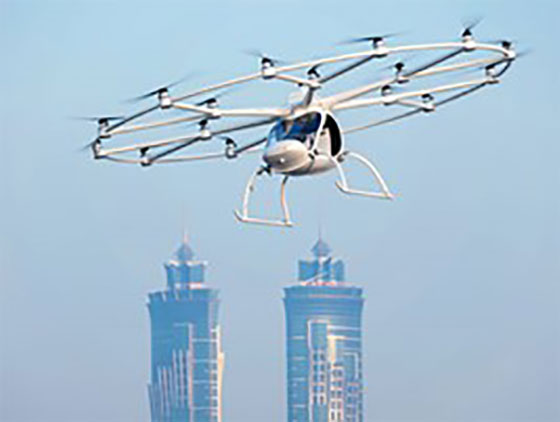
Seismic Shifts Ahead
We’re going to make sure that you are well prepared for the seismic shifts that are right around the...


Once we have more self-driving aircraft flying in any given metropolitan area, we’ll need to know where they all are to keep the airspace safe. Fortunately, we’re seeing some breakthroughs that will solve the biggest challenges facing this future-of-travel trend…

Dear Reader,
Last year, we knew that the economic lockdowns were going to be terrible for some businesses. The hotel industry, cruise lines, and car rental agencies all suffered terribly.
Yet this new world was a boon for certain technology companies – companies that were enabling what I call “digital leaps.”
A digital leap is when an industry transitions from slow, analog systems to new, bleeding-edge technologies.
As just one example, think of the music industry back in the 1990s and early 2000s. We abandoned our Walkman portable media players in favor of iPods… and then left even those devices behind in favor of streaming music.
And these digital leaps can be some of the most powerful market opportunities for investors. In 2020 alone, streaming services generated over $10 billion in revenue for companies like Apple and Spotify.
The good news is that we’re on the cusp of a brand-new digital leap in a massive $11.9 trillion industry. Up until the pandemic, it was caught up in red tape, bureaucracy, and manual processes. But now that’s all changing fast…
This digital leap is not only going to make our lives better… It’s also going to provide investors a whole new opportunity to profit. This could very well be the last major industry to undergo a digital leap, so I don’t want any of my readers to miss out.
And even better, I believe I’ve found the company sitting at the center of this story.
I’m preparing to share all the details on April 7 at 8 p.m. ET. I invite you to join me that night for my America’s Last Digital Leap event.
It’s an event no one should miss. So please go right here to reserve your place I hope to see you there.
Now let’s turn to today’s mailbag questions…
If you have a question you’d like answered next week, please be sure you submit it right here.
Let’s begin with a question on the rise of intracity air travel:
As someone who has worked in commercial aerospace (mostly Flight Management Systems), I am always interested to see new ventures like Volocopter, but at the same time amazed that no one is really discussing the aspects of Air Traffic Control (ATC) that need to be addressed to allow these technologies to be implemented.
With so many proposed systems for the urban environment (air taxis, delivery drones, etc.), there absolutely must be an ATC system in each major urban area in order to coordinate traffic to avoid mid-air collisions, make the call about no flying in bad weather, coordinate geo-fencing (especially in emergency situations), and provide the necessary data when an accident does happen.
Each urban ATC (UATC) would need to take into account the unique features of each urban center (geography, tall buildings, airports, etc.) in order to provide the proper geo-fencing and real-time traffic control necessary.
I would propose that much of this can and should be automated – for example, downloading current restrictions (e.g., geo-fencing for an emergency situation), uploading a flight plan that takes the current restrictions into account, and then providing in-flight feedback relative to the flight plan as well as current conditions.
I don’t see the Federal Aviation Administration (FAA) being able to do something like this, though it would need to be involved. But I really see someone or some group like Amazon/UPS/FedEx getting this done. Funding would come from real-time pricing built into the system (i.e., higher costs in higher traffic areas/times) once the system is up and running. Are you aware of any such efforts?
– Mike M.
Hello, Mike – thanks for writing in. It’s always great to hear from readers with personal experience in the topics we cover in The Bleeding Edge.
And you’re spot on. I’ve had the same exact thought on several occasions.
I used to fly Cessna 172’s when I was getting my private pilot’s license. That was back when I was earning my degree in aeronautical and astronautical engineering at Purdue University. It’s been a long time since I’ve flown my own plane, and I have been meaning to start up again.
Depending on where we are flying, there can be a lot of chatter with ATC to get where we need to go. To your point, if we have several hundred more aircraft flying in any given metropolitan area during any given time of the day, we’re going to need to know where they all are to keep the airspace safe.
And as you correctly pointed out, it would be nearly impossible for ATC to manage this level of activity.
I’ve also noticed that investor presentations from private companies working in this space have conveniently left out this particular topic that you brought up. I’ll explain the reasons why in a bit. For other readers, here’s some more background.
We’ve been covering the future of transportation for some time now. And it’s amazing how much development we’re seeing in this space. As you mentioned, we recently wrote about Volocopter, an air taxi startup that announced its plans to go public.
Volocopter Aircraft

Source: Volocopter
And Volocopter is in good company. Joby Aviation is working on another aircraft intended for the air taxi space.
Joby Aviation Aircraft

Source: Joby Aviation
And another company called Kitty Hawk is developing an autonomous aircraft capable of longer distances as well… Light, autonomous aircraft like this could transform the entire aviation landscape.
Kitty Hawk Aircraft

Source: Tech Crunch
And even the legacy airlines realize the importance of this trend. This year, United Airlines invested in a company called Archer Aviation that is also developing electric aircraft intended for shorter travel.
And all these examples are a mere sampling of the rapid progress we’re seeing in this space. Sooner than we can imagine, we’ll have multiple options for commuting to work by plane.
And these won’t be the only new additions to our skies. Drones are also on the rise. And the FAA even gave an early stage company called American Robotics permission to fly autonomous drones in the U.S.
This is on top of work that companies like Amazon, Google, and UPS have been doing in this space. Soon, it will be normal for a drone to drop off packages or food deliveries.
This is why I’ve said autonomous technology will be one of the biggest stories of 2021. We’re going to see an explosion of products and services coming out.
But as you pointed out, one of the biggest challenges we’ll face with this increase in air traffic will be regulatory. We’re going to have to figure out how to manage traffic in a world where air taxis and other flying vehicles are everywhere.
And we’ve seen some progress.
At the start of 2020, the FAA began requiring all airplanes and helicopters to broadcast their positions using Automatic Dependent Surveillance–Broadcast (ADS-B) equipment. We can think of it as a beacon that projects the aircraft’s location.
The FAA said it anticipated this change would enable aircraft to fly more direct routes, saving time and fuel. And controllers would be able to reduce the minimum separation distance between aircraft, increasing capacity in the nation’s airways.
This change also makes it easier for a drone operator to steer clear of any nearby aircraft. We’ll need to install these ADS-B receivers onto drones so they can autonomously identify nearby aircraft.
Enabling automatic detection is what I like to think of as building the infrastructure. The intelligence will come through using artificial intelligence (AI) for the purposes of autonomous flight. This is what will enable these new aircraft to fly safely from point to point without incident.
And back to my earlier point, here’s why we don’t hear much about this issue from the companies developing these new technologies:
The FAA has already been supportive of enabling autonomous drone deliveries. The assumption is that it will also accommodate regulations that will enable autonomous air taxis.
While early flights will begin within the next 18 months, it will still be a few years before we see the start of a well-established air taxi network with high volumes of passengers. In other words, there is time. All of the companies are working through the process, using the existing system for now, and planning for a new construct for this kind of air travel.
As I suggested above, once the general framework is in place from the FAA for use of airspace, autonomous flying technology coupled with autonomous detection technology will ensure safe flights and avoid crashes even with busy skies. And this will be accomplished without being a burden on existing ATC.
This is a huge undertaking, building the future of transportation. While there is a tremendous amount of work being done this year, this particular theme will become exciting in 2022, and it’s one that I’ll be following closely.
And when possible, I’ll look to experience it for myself. Bleeding Edge readers will be the first to know when I do.
Next, a reader wants to know more about special purpose acquisition corporations (SPACs):
Hi, what happens if I do not split the SPACS due to the high cost of doing this compared to the value of the units. Will the unsplit units continue to trade?
– Clive l.
Hey there, Clive. Thanks for sharing this question. SPACs – also called “blank check” companies – are an investment vehicle many people are still learning about. And while I can’t offer personalized advice, I can definitely give you an explanation of our strategy for Blank Check Speculator.
As a refresher, SPACs are public companies that exist for one purpose: to combine with a private company in order to take it public. That allows regular investors the rare opportunity to essentially invest in a private company before it goes public, which is when the greatest gains are possible.
And in this research service, we are investing in units of SPACs, which will split into shares and some amount of warrant coverage. We simply need to contact our broker after the split to change our units into shares and warrants.
As for choosing to not split our units… The SPAC units will generally cease trading when the business combination with the private company takes place. At that point, all units will be automatically split into shares and warrants of the company the SPAC took public.
So why do I instruct subscribers to split units early? Why not just wait for the business combination?
The answer is that splitting units gives us flexibility. By splitting units early, we have the option to sell our shares. Not only are we able to recover our initial investment this way, but we can often do so at a meaningful profit.
Then we can choose to hold our warrants as a “free lottery ticket.” This tends to be a good strategy, especially for those with limited capital to deploy investing in SPACs. By selling shares, that capital can be reinvested in another SPAC to pick up more warrants.
Or let’s imagine a scenario where a business combination is announced but not yet completed. It’s very possible – even likely – that the SPAC could move higher with the anticipation. Again, we have options. We could choose to sell our shares or warrants during the excitement and hold on to the other security through the business combination.
I want to optimize my subscriber’s returns with these investments. And splitting units early is the best way to do that. That’s why I make that recommendation. But the decision on which strategy to use is ultimately up to each individual investor.
Finally, as you noted, brokers do charge a fee for executing the split. The fees vary depending on your broker.
Some brokers like Interactive Brokers and Vanguard may charge as much as $300 to do so. But others like TD Ameritrade, Fidelity, and Charles Schwab charge just $39 per split.
If the fees at one broker are prohibitive, I would encourage subscribers to consider switching to another option for our SPAC investments.
Let’s conclude with some feedback on our new Brownstone Research app:
Jeff, kudos for the new app. I was coming back from a day of scuba diving on a boat in the Gulf of California (Sea of Cortez), got a buy alert, got in right on the buy-up-to price. Got a buy alert between planes at LAX. Got in on that one. Thank you for the new app!
– Gloria B.
Hi, Gloria, and thanks for writing in. It sounds like you had a fantastic trip. I’m jealous. I used to go diving all the time. I have my advanced open water and rescue diver certifications, but sadly I haven’t spent much time in the water since my kids were born.
And I’m glad that you’ve found our new smartphone app to be useful. We’ve been working on the Brownstone Research app for months, so we were happy to finally unveil it for subscribers.
This app was especially important to me as it enables us to provide real time support for all of our subscribers, including those that live outside North America. This is an issue that I’m very sensitive to, as I lived and worked almost my entire adult life overseas.
I know how bad the delays can be with text messages through international carriers. That’s something that is completely out of our control, which is why the app is so important for us to have.
And it will only get better as we make small improvements here and there.
If any subscribers haven’t yet downloaded it, you can find the app in the Google Play store (for Android devices) or the Apple App Store (for iOS devices).
You can log in using your normal Brownstone Research account credentials. And make sure you allow notifications from the app in your smartphone settings. That way you should receive timely notifications going forward.
That’s all we have time for this week. If you have a question for a future mailbag, you can send it to me right here.
Have a great weekend.
Regards,
Jeff Brown
Editor, The Bleeding Edge
Like what you’re reading? Send your thoughts to feedback@brownstoneresearch.com.

Read the latest insights from the world of high technology.

We’re going to make sure that you are well prepared for the seismic shifts that are right around the...

After decades of hesitation, the tide has finally turned. For the first time in a generation, global institutions, governments,...
